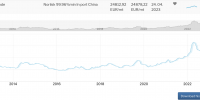Critical raw materials such as copper, cobalt or rare earths often occur in their deposits as smaller and smaller ore grains. Thus, they are too small for the common separation by flotation. The project partners of FineFuture now want to explore the flotation of very fine mineral particles and develop new technological solutions.
Rising prices and a growing global demand for strategically important, technologically interesting metals are responsible for this. Thus, more and more deposits appear interesting, whose degradation was previously regarded as uneconomical. Because the desired ores occur in the rock as low concentrated and finely distributed; the technical effort for their extraction is enormous.
Yield results can be influenced
"Foam flotation is the most important method in the mining industry to extract valuable raw materials from ore," explains Dr. Ing. Martin Rudolph from the Helmholtz Institute Freiberg for Resource Technology. In the process, finely ground mineral particles are fed into a liquid gas bubbles. The bubbles adhere to particles with a water-repellent surface, rise up with them and form a foam layer that can be skimmed off. Special reagents provide for attachment to the desired minerals, promote the sinking of unwanted particles or stabilize the foam. With factors such as the amount of gas supplied and bubble size, turbulence degree of the flow, reagents used and adhesion energies, the yield results can be influenced.
Many questions left
However, many fundamental questions on the chemical mechanisms and micro-processes involved have yet to be clarified before the separation of mineral particles in the size range from 0,1 to 20 micrometers on an industrial scale will be possible in the future. Two of the nine work packages of the FineFuture project are devoted to issues such as binding mechanisms and foam behavior of the recyclable particles as well as turbulent flows in the flotation tank. And three working groups want to improve the yield of fine particle flotation by simulating flow conditions and investigating interactions.
Also important for recycling
Under the coordination of the Helmholtz-Zentrum Dresden-Rossendorf and alongside leading European research institutes, seven companies from mining, processing and plant construction are involved in FineFuture. They hope for higher recovery rates, more sustainable processes and lower flotation residues. Want to combine process innovations in such a way that the recovery rate increases by 30 percent compared to today's level. And expect that in many heaps still precious fine particles are slumbering, which should be made usable. New technology could reduce landfills, reducing land use and environmental hazards. However, it would also be of great importance for raw material recovery from Althalden or recycling.
The EU is funding the three-year project with over 6,2 million. The consortium is international with teams from Belgium, Bulgaria, Germany, France, Greece, Italy, Poland, Spain, Turkey and the United Kingdom.

